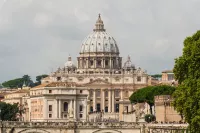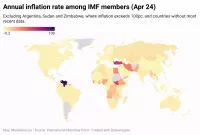Newfoundland and Labrador, Canada's easternmost province, encompasses the island of Newfoundland and the Labrador region, totaling 405,212 km2. Its estimated 2024 population is 545,880, with about 94% residing on Newfoundland, primarily on the Avalon Peninsula. Labrador shares a border with Quebec and a short border with Nunavut on Killiniq Island. Saint Pierre and Miquelon, a French overseas collectivity, lies 20 km west of the Burin Peninsula.
1900: Visiting Artists
Until about 1900, most art was the work of visiting artists, who included members of the Group of Seven, Rockwell Kent and Eliot O'Hara.
1902: "Ode to Newfoundland" Written
In 1902, the "Ode to Newfoundland" was written by British colonial governor Sir Charles Cavendish Boyle.
May 20, 1904: Anthem Adoption
On May 20, 1904, the "Ode to Newfoundland" was adopted as the official Newfoundland anthem.
1907: Dominion Status
In 1907, Newfoundland acquired dominion status, or self-government, within the British Empire or British Commonwealth.
1908: Fishermen's Protective Union
From 1908, the Fishermen's Protective Union (FPU) began mobilizing more than half of Newfoundland's fishermen.
1910: Fishing Disputes Settlement
In 1910, disputes over fishing rights with the New England states were settled.
1910: Fishing Rights Arbitration
In 1910, fishing rights were confirmed by arbitration.
1911: Rossleys Performances
Between 1911 and 1917, Rossleys, a "vaudeville-style performance troupe", put on blackface minstrelsy shows which were a popular source of entertainment in Newfoundland.
1913: FPU in the House of Assembly
In the 1913 general election, the candidates for the FPU won 8 of 36 seats in the House of Assembly.
1914: Economic Conditions
At the beginning of 1914, economic conditions seemed favourable to reform.
July 1, 1916: Beaumont-Hamel
On July 1, 1916, the 1st Newfoundland Regiment was nearly wiped out at Beaumont-Hamel on the first day on the Somme.
1917: Rossleys Performances
Between 1911 and 1917, Rossleys, a "vaudeville-style performance troupe", put on blackface minstrelsy shows which were a popular source of entertainment in Newfoundland.
1917: National Government
In 1917, the FPU members joined Edward Patrick Morris' wartime National Government.
1918: NIWA Strike
In 1918, the Newfoundland Industrial Workers' Association (NIWA) struck the rail and steamship operations of the Reid Newfoundland Company.
January 1919: Dáil Éireann Formed
In January 1919, Sinn Féin formed the Dáil Éireann in Dublin.
1919: Liberal Reform Party
In 1919, the FPU joined with the Liberals to form the Liberal Reform Party.
1920: Self-Determination for Ireland League
In 1920, many Catholics of Irish descent in St. John's joined the local branch of the Self-Determination for Ireland League (SDIL).
1923: Newfoundland Verse
In 1923, E. J. Pratt published his "breakthrough collection" Newfoundland Verse.
1927: Labrador Border Dispute
In 1927, the British Judicial Committee of the Privy Council ruled that modern-day Labrador was to be considered part of the Dominion of Newfoundland.
1929: Stock Market Crash
Following the stock market crash in 1929, the international market decreased dramatically.
1930: Export Revenue
In 1930, the country earned $40 million from its exports.
1931: Dominion Default
In 1931, the Dominion defaulted.
1932: Salted Cod Price
By 1932, salted cod that sold for $8.90 a quintal in 1929 fetched only half that amount.
1933: Loss of Self-Governance
In 1933, the House of Assembly voted to dissolve itself and hand over administration to a British-appointed Commission of Government due to economic struggles.
1933: Export Revenue Decrease
In 1933, the country earned $23.3 million from its exports.
1933: Legislature Decision
In 1933, the legislature in St. John's voted itself out of existence.
February 16, 1934: Commission of Government
On February 16, 1934, the Commission of Government was sworn in, ending 79 years of responsible government.
1934: Commission of Government
From 1934, the Commission of Government managed the situation, but the underlying problem resisted solution.
1936: The Eyes of the Gull
In 1936, Margaret Duley published "The Eyes of the Gull".
June 1939: Royal Visit
In June 1939, King George VI and Queen Elizabeth visited.
September 1939: War Commitment
In September 1939, Newfoundland and Labrador was automatically committed to war as a result of Britain's ultimatum to Germany.
1939: Cold Pastoral
In 1939, Margaret Duley published "Cold Pastoral".
June 1940: Canadian Forces
In June 1940, following the defeat of France, the Commission of Government authorized Canadian forces to help defend Newfoundland's air bases.
November 1940: Gander Airbase
From November 1940, a new airbase at Gander became one of the so called "sally-ports of freedom".
1940: Art Societies Prominence
Local art societies became prominent in the 1940s, particularly The Art Students Club, which opened in 1940.
1941: Highway to Valour
In 1941, Margaret Duley published "Highway to Valour".
March 31, 1949: Confederation with Canada
On March 31, 1949, Newfoundland became the 10th province to join the Canadian Confederation.
1949: Joining Canada
After Newfoundland and Labrador joined Canada in 1949, government grants fostered a supportive environment for visual artists, primarily painters.
1950: Visual Arts Development
Before 1950, the visual arts were a minor aspect of Newfoundland cultural life, compared with the performing arts such as music or theatre.
1961: Pratt Returns
In 1961, Newfoundland-born painters Christopher Pratt and Mary Pratt returned to the province to work at the newly established Memorial University Art Gallery as its first curator.
1962: Symphony Orchestra Began
The Newfoundland Symphony Orchestra began in St. John's in 1962 as a 20-piece string orchestra known as the St. John's Orchestra.
1966: Tomorrow Will Be Sunday
In 1966, Harold Horwood published "Tomorrow Will Be Sunday".
1967: Arts and Culture Centre Opened
In 1967 the St. John's Arts and Culture Centre was opened along with the first all-Canadian Dominion Drama Festival.
1968: Margaret Duley's Death
Margaret Duley, Newfoundland's first novelist to gain an international audience, died in 1968.
1969: Squires Returns
In 1969, Newfoundland-born artist Gerald Squires returned to the province.
1970: House of Hate
In 1970, Percy Janes published "House of Hate".
1972: White Eskimo
In 1972, Harold Horwood published "White Eskimo".
1973: Labrador Flag Creation
In 1973, Labrador's own unofficial flag, created by Mike Martin, former Member of the Legislative Assembly for Labrador South, was created.
1978: UNESCO World Heritage Site
In 1978, L'Anse aux Meadows, Newfoundland, was declared a World Heritage Site by UNESCO due to archaeological evidence of a Norse settlement.
May 28, 1980: Provincial Flag Adoption
On May 28, 1980, Newfoundland and Labrador's present provincial flag, designed by Newfoundland artist Christopher Pratt, was officially adopted by the legislature and first flown on "Discovery Day" that year.
1980: Art Opportunities Developed
From 1980 to present, opportunities for artists continued to develop, as galleries such as the Art Gallery of Newfoundland and Labrador (which later became The Rooms Provincial Art Gallery), the Resource Centre for the Arts, and Eastern Edge were established.
1980: Re-adoption as Provincial Anthem
In 1980, the province re-adopted the "Ode to Newfoundland" as an official provincial anthem.
1987: Kittiwake Dance Theatre Founded
In 1987, the Kittiwake Dance Theatre was founded; it is the oldest non-profit dance company in Newfoundland.
June 20, 1988: End of Newfoundland Railway
On June 20, 1988, the Newfoundland Railway ended as part of the rails for roads deal.
April 29, 1999: Motion for Name Change
On April 29, 1999, the government of Brian Tobin passed a motion requesting the federal government amend the Newfoundland Act to change the province's name to "Newfoundland and Labrador".
2000: Dorset Culture
Around the year 2000 BC, the Maritime Archaic peoples were gradually displaced by people of the Dorset culture.
October 2001: Resolution for Name Change
In October 2001, a resolution approving the name change was put forward in the House of Commons by Tobin.
December 6, 2001: Name Change
On December 6, 2001, the Constitution of Canada was amended to change the province's name from "Newfoundland" to "Newfoundland and Labrador".
2001: River Thieves
In 2001, Michael Crummey's debut novel, River Thieves, became a Canadian bestseller.
2003: The Town That Forgot How to Breathe
In 2003, Kenneth J. Harvey published "The Town That Forgot How to Breathe".
2005: Alligator
In 2005, Lisa Moore published her first novel, Alligator, which is set in St. John's and incorporates her Newfoundland heritage.
2006: Inside
In 2006, Kenneth J. Harvey published "Inside".
2006: Tourism Spending
In 2006, nearly 500,000 non-resident tourists visited Newfoundland and Labrador, spending an estimated $366 million.
2008: Blackstrap Hawco
In 2008, Kenneth J. Harvey published "Blackstrap Hawco".
2008: Fogo Island Arts Creation
In 2008, the creation of Fogo Island Arts on Fogo Island created a residency-based contemporary art program for artists, filmmakers, writers, musicians, curators, designers, and thinkers.
2009: Come Thou Tortoise
In 2009, Jessica Grant published "Come Thou Tortoise".
2010: Trans-Labrador Highway Completion
In 2010, the Trans-Labrador Highway was completed, which allowed access from Blanc-Sablon, Quebec, to major parts of Labrador.
2011: Artist Study
As of 2011, a study documented approximately 1,200 artists in Newfoundland and Labrador, representing 0.47% of the province's labour force.
2011: Provincial Election
In the 2011 provincial election, the New Democratic Party had a major breakthrough and placed second in the popular vote behind the Progressive Conservatives.
2013: Venice Biennale Representation
In 2013, Newfoundland and Labrador was represented at the Venice Biennale as Official Collateral Projects.
2013: First Amateur Teams Form
It was not until 2013 that Newfoundland and Labrador saw its first amateur gridiron football teams form.
2015: Venice Biennale Representation
In 2015, Philippa Jones became the first Newfoundland and Labrador artist to be included in the National Gallery of Canada contemporary art biennial, and also the province was represented at the Venice Biennale as Official Collateral Projects.
2016: Census Results
According to the 2016 census, 97.0% of residents reported English as their native language, which made Newfoundland and Labrador Canada's most linguistically homogeneous province.
2017: We'll All Be Burnt in Our Beds Some Night
In 2017, Joel Thomas Hynes published "We'll All Be Burnt in Our Beds Some Night".
2017: Tourism Revenue
In 2017, non-resident tourists spent an estimated $575 million in Newfoundland and Labrador.
2017: Per Capita GDP
In 2017, the per capita GDP in Newfoundland and Labrador was $62,573, higher than the national average and third only to Alberta and Saskatchewan out of Canadian provinces.
2017: AHL Presence Until
Until 2017, Newfoundland had an intermittent American Hockey League presence with the St. John's Maple Leafs then St. John's IceCaps.
2018: Growlers Inaugural Season
In 2018, the Newfoundland Growlers of the ECHL played at Mary Brown's Centre (formerly Mile One Centre) in St. John's, from the 2018–19 to 2023–24 seasons.
2018: Total Labour Force
In 2018, the total labour force in Newfoundland and Labrador was 261,400 people.
2021: YYT Airport Expansion
In 2021, the St. John's International Airport (YYT) underwent a major expansion of the terminal building.
2023: Growlers Last Season
In 2023, the Newfoundland Growlers of the ECHL played at Mary Brown's Centre (formerly Mile One Centre) in St. John's, from the 2018–19 to 2023–24 seasons.
April 2024: Growlers Operations Cease
In April 2024, the Newfoundland Growlers of the ECHL ceased operations.
2024: Shirt Sponsors
In 2024 Newfoundland and Labrador became the shirt sponsors of Barrow A.F.C., an association football (soccer) team located in North West England.
2024: Population Estimate
In 2024, the estimated population of Newfoundland and Labrador was 545,880.
2024: Moose Symbol Adoption
On Newfoundland, as of 2024 moose have become an increasingly adopted symbol of the island.
2025: Titan Relocation
In 2025, the Acadie–Bathurst Titan are scheduled to relocate to St. John’s to become Newfoundland Regiment in the QMJHL.
Mentioned in this timeline

The stock market serves as a platform where buyers and...
Germany officially the Federal Republic of Germany is a Western...

The Catholic Church the largest Christian church globally with over...

Inflation in economics signifies an increase in the average price...

Football is a family of team sports primarily involving kicking...
France officially the French Republic is primarily located in Western...
Trending
2 months ago Belgium Defeats Wales 4-2, Jeopardizing World Cup Hopes; De Bruyne Scores Twice.

2 months ago Beyoncé and Jay-Z Spotted in Qatar: Headscarf Sparks Debate.
1 month ago Typhoon Kalmaegi Devastates Philippines: Hundreds Dead, Another Storm Threatens Hope

1 month ago Sofía Vergara: Comfort Style, 'Dune' Ambition, and Skechers Brand Ambassador
4 months ago Uber faces scrutiny over safety record and sexual assault allegations, raising concerns.

29 days ago MacBook Pro M5 Issues Reported; Amazon Offers Black Friday Deals on MacBooks.
Popular

Candace Owens is an American conservative political commentator and author...

Tucker Carlson is an American conservative political commentator known for...

XXXTentacion born Jahseh Dwayne Ricardo Onfroy was a controversial yet...

Ben Shapiro is a prominent American conservative political commentator media...

Bill Gates an American businessman and philanthropist revolutionized personal computing...

Kashyap Pramod Patel is an American lawyer who became the...